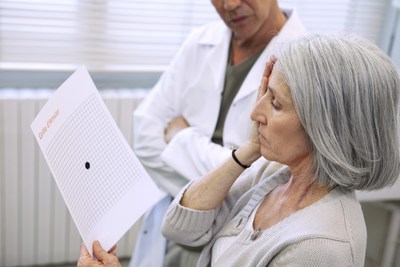SAN FRANCISCO, Feb. 6, 2018 /PRNewswire-USNewswire/ -- Age-related macular degeneration (AMD) is the most common cause of vision loss and blindness in Americans over age 50, affecting about 2.1 million people nationwide. Early diagnosis and treatment are the keys to preventing vision loss. During February, the American Academy of Ophthalmology is educating the public about the facts on AMD.


AMD is a degenerative disease that happens when part of the retina called the macula is damaged. It's the part of the eye that delivers sharp, central vision needed to see objects straight ahead. Over time, the loss of central vision can interfere with everyday activities, such as the ability to drive, read, and see faces clearly.
Ophthalmologists – physicians who specialize in medical and surgical eye care – have more tools than ever before to diagnose the disease earlier, and to treat it better. But these advances cannot help patients whose disease is undiagnosed, or patients who are unaware of the seriousness of their disease. People's lack of understanding about AMD is a real danger to public health. A recent study showed that most people with AMD don't realize it's a chronic health issue that requires regular attention for the rest of their lives.
The Academy offers these seven steps to help people take control of their eye health:
- Get regular comprehensive medical eye exams. AMD often has no early warning signs, so getting regular comprehensive eye exams from an ophthalmologist is critical to diagnosing and treating the eye disease in its early stages. The Academy recommends that adults with no signs or risk factors for eye disease get a baseline eye disease screening at age 40 — the time when early signs of disease and changes in vision may start to occur. By age 65, the Academy recommends getting an exam every one to two years, even in the absence of symptoms or eye problems.
- Quit smoking. Numerous studies show smoking increases the risk of developing AMD, and the speed at which it progresses. Smokers are twice as likely to develop macular degeneration compared with a nonsmoker.
- Eat a well-balanced diet. Many studies demonstrate that eating a diet rich in fruits, vegetables, and nutrient-packed foods, such as salmon and nuts, may reduce the risk of AMD. Research also suggests that patients who ate fresh fish, an important source of omega-3s, were at lower risk of developing AMD.
- Take the right kind of vitamins. Vitamins can delay progression of advanced AMD and help people keep their vision longer if they have intermediate AMD or advanced AMD in one eye. But make sure it's the right combination of vitamins. A recent study found that some of the top-selling products do not contain identical ingredient dosages to eye vitamin formulas proven effective in clinical trials.
- Exercise regularly. Exercising three times a week can reduce the risk of developing wet AMD by 70 percent. Studies also show that physical activity may lower the odds of both early and late-stages of AMD.
- Monitor your sight with an Amsler Grid. This simple, daily routine takes less than one minute and can help people with AMD save more of their vision. Using this grid is essential to finding any vision changes that are not obvious, so you can report them to your ophthalmologist.
- Know your family's eye health history. If you have a close relative with AMD, you have a 50 percent greater chance of developing the condition. Before your next eye exam, speak with your family about their eye health history. You may need more frequent eye exams based on your family history.
"While new treatments and technologies are helping patients keep more of their vision than ever before, early detection remains your best defense against AMD," said Rahul N. Khurana, MD, a clinical spokesperson for the American Academy of Ophthalmology. "Get a baseline, comprehensive exam at age 40. After age 65, get an exam every one to two years, even if you have no symptoms. Your good vision depends on it."
EyeCare America® Helps Save Seniors' Sight
For individuals age 65 or older who are concerned about their risk of eye disease, you may be eligible for a medical eye exam often at no out-of-pocket cost through the American Academy of Ophthalmology's EyeCare America® program. For those at increased risk for glaucoma, they may qualify for a glaucoma exam through EyeCare America. This public service program matches volunteer ophthalmologists with eligible patients in need of eye care across the United States. To see if you or a loved one qualifies, visit EyeCare America to determine your eligibility. For more information on age-related macular degeneration or other eye conditions and diseases, visit the American Academy of Ophthalmology's EyeSmart® website.
About the American Academy of Ophthalmology
The American Academy of Ophthalmology is the world's largest association of eye physicians and surgeons. A global community of 32,000 medical doctors, we protect sight and empower lives by setting the standards for ophthalmic education and advocating for our patients and the public. We innovate to advance our profession and to ensure the delivery of the highest-quality eye care. Our EyeSmart® program provides the public with the most trusted information about eye health. For more information, visit aao.org.
SOURCE American Academy of Ophthalmology
Related Links
WANT YOUR COMPANY'S NEWS FEATURED ON PRNEWSWIRE.COM?
Newsrooms &
Influencers
Digital Media
Outlets
Journalists
Opted In
Share this article